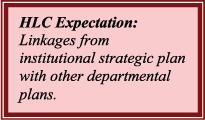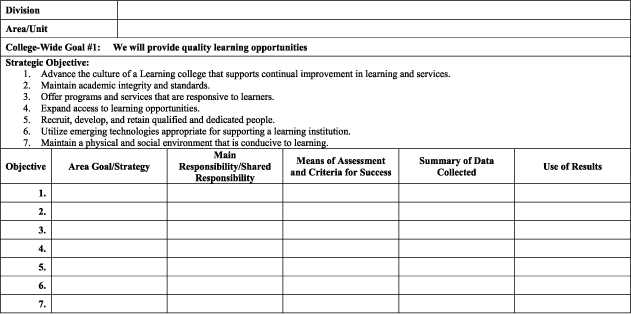

Operational Plan Accomplishments
A summary report of the
previous year's operational plans is presented to OPIC in November.
Annually, each department creates a plan of
its activities and relates each activity to specific College
objectives, using an operational plan template. The template lists
the strategic goals and the objectives related to each goal. It
contains six columns, four of which are filled in when the plan is
made and two which are completed when the department reports on its
accomplishments at year's end. The objective to which each planned
activity is related is identified in the first column and the
planned activity is described in the second column. The person who
is assigned responsibility for the activity is identified in the
third column and the means for determining if the activity was
successful is described in the fourth column. The final two columns
show a description of the results or data collected and the
implications of the results. A sample template appears in
Illustration 10 (The 4-page template is provided
in its entirety as Appendix I):
creates a plan of
its activities and relates each activity to specific College
objectives, using an operational plan template. The template lists
the strategic goals and the objectives related to each goal. It
contains six columns, four of which are filled in when the plan is
made and two which are completed when the department reports on its
accomplishments at year's end. The objective to which each planned
activity is related is identified in the first column and the
planned activity is described in the second column. The person who
is assigned responsibility for the activity is identified in the
third column and the means for determining if the activity was
successful is described in the fourth column. The final two columns
show a description of the results or data collected and the
implications of the results. A sample template appears in
Illustration 10 (The 4-page template is provided
in its entirety as Appendix I):Assessment
The Assessment Committee presents its report to OPIC in December. The report summarizes the status of assessment along with recommendations and planned actions. A complete description of the assessment process is included in Chapter 4.
Budget Cycle
The Vice President of College Services heads the budgeting process which occurs over a period of up to ten months. In January, a budget projection for the current fiscal year and a forecast for the next ten years are prepared based on economic and enrollment trends. This document is presented to the Board and to OPIC in January or February. Beginning in March, budget input is sought from departments through their requests, for the next fiscal year. During the month of April, the Business Office compiles the preliminary requests and refinements are made. Major expenditures are linked with specific strategic goals and objectives. Also in April, the preliminary budget is presented to OPIC, which considers the requests in light of the information they have previously received from the various information streams, and they make funding recommendations based on the alignment of those recommendations with the strategic goals and objectives. The budget is further refined, the links to the operational plan are summarized, and the tentative budget is presented to the Board by its June meeting. The Board approves the final budget a month or two later, and the document is submitted to the ICCB by the October 15 deadline.2005-2006 Goals and Priorities

Illustration 11: Operational Plan Template Sample
Assigning Responsibility
The effectiveness of the entire committee structure is tied to
committee members fully understanding their respective committee's
responsibilities and completing their committee responsibilities on
time. To clearly communicate each committee's responsibility to the
members and to members of other committees, a charge� was created
for every committee that identifies membership, tasks, and
timelines for task completion. The committee charge is reviewed
with each chair, and each chair accepts responsibility for the
timely completion of committee responsibilities. The President, as
the OPIC co-chair, accepted overall responsibility for the timely
completion of all tasks and reports to the Board of
Trustees.
The System
The new committee structure and planning cycle were
implemented during 2004 and 2005. However, the final structure
revisions and the need to clarify responsibilities (as discussed
above) caused a late start and delays in committee progress. The
administration encouraged the committees to take the time they
needed during this initial cycle to resolve the issues well. By
doing so, committee members gained a full understanding of their
charges and embraced their assignments. Many of the
responsibilities did end up being finished on time, while others
fell behind. However, those committees that fell behind were
encouraged to continue their efforts, and all eventually completed
their assigned activities.
Since the process was running behind schedule, in the spring of
2005 OPIC chose to delay strategic planning. Instead, they
scheduled a day-long retreat during the summer. The strategic
planning retreat was held on July 18, 2005, at an off-campus site.
Twenty-two of the twenty-six members, including six faculty, two
support staff, fourteen administrators, the College's new
President, George Mihel, on his first day at Sauk, and one student,
attended the day-long event. The retreat was facilitated by Thomas
Gospodarczyk, Dean of Adult Educational Services, with
presentations also made by others.
At the retreat, OPIC reviewed the College's mission, core values,
philosophy, and strategic goals and objectives, and examined the
role that each plays in guiding the College's activities.
Information and terminology on the learning college model and
shared governance were presented in an effort to assure a common
understanding. By consensus, it was decided to maintain the current
mission, values, philosophy, and strategic goals and objectives for
another year. Further, it was determined that the College should
create and adopt a vision statement and review the strategic goals
and objectives in time for the 2006 and 2007 year. The retreat minutes appear as
Appendix J.
System Changes
OPIC and some of the committees also agreed that the short, monthly meetings originally scheduled during 2004 and 2005 did not allow adequate time to conduct business and that longer meetings with better scheduling were needed. A committee also recommended that committee assignments be determined in the spring prior to faculty's leaving for the summer, so committees could convene and begin their work earlier in the fall. Both recommendations were implemented for 2005 and 2006.
Presidential Leadership
Dr. Mihel, who began his tenure as president in July of 2005, joined the College as the reorganizing efforts were well along. He was supportive of the efforts and as he became acquainted with the institution and the new systems, and he worked to improve communications. Besides conducting discussions with the full faculty at several discussion hours, Dr Mihel scheduled private meetings with all of the faculty and administrators in their respective offices. He also worked through the corporate services office to schedule visits to and meetings with management at the major local employers. Working with the Board of Trustees to assure their knowledge of and involvement with the College's planning activities, he encouraged the Board's increased involvement with strategic planning, and they responded by assuming responsibility for setting the College's vision and establishing strategic goals in a timely fashion that would flow into OPIC's planning cycle.
Vision of the Board of Trustees
One of the Board's major responsibilities is to approve and
monitor the College's institutional budget. The budget is
presented to the Board along with a discussion highlighting its
relationship to specific strategic goals and objectives. The Board
considers the proposed budget and the funding recommendations made
by OPIC as these relate to the College's strategic goals and
objectives.
While the College has operated under various stated purposes,
goals, and philosophies over its forty-year existence, the Board of
Trustees has become involved with the institution's strategic
planning by assuming responsibility for writing the College's
vision statement and establishing strategic goals. A Board retreat,
conducted on January 20, 2006, was conducted for the Board to begin
drafting the College's mission, vision, and
strategic goals.







